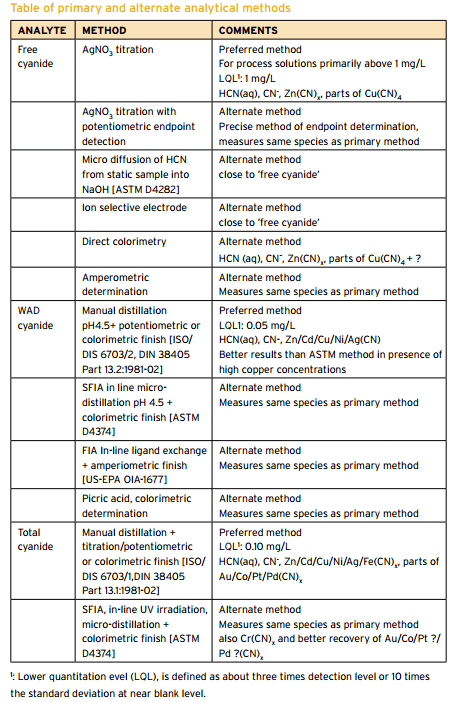It is important to make use of composite sampling and to take at least five samples. Grab samples may be representative of flow during a short period and any other sample shown to be representative of waters being sampled may be applicable.
The collection of samples for cyanide determination will require treatment to preserve the constituents. Procedures such as those described by APHA and ASTM are complicated and not easily undertaken in the field. This problem can be overcome by using a field laboratory facility or truck.
General conditions applying to sample preservation
- Cyanide species exist as cyanide ion, molecular cyanide and/or metal cyanide complexes
- Thiocyanate, ammonia and cyanate may be present
- Iron cyanide complexes are subject to photolytic degradation
- Metal cyanide complexes vary in stability and solubility
- Thiocyanate acts as an interference
- Sulfides and reduced sulfur compounds interfere through formation of thiocyanate
- Oxidants such as residual chlorine or hydrogen peroxide are known to interfere.
Factors affecting cyanide stability prior to analysis
- Cyanide standards in de-ionised water, preserved by the addition of sodium hydroxide to pH > 12 and kept at 4°C in the dark, are generally stable.
- Complex solutions from gold processing waters are unlikely to be stable or represented if preserved only as above.
- Exposure to light will cause degradation of iron cyanide complexes. Elevated temperatures and agitation will cause loss of cyanide from solution.
- Sulfide or reduced sulfur compounds must be removed prior to pH elevation to prevent thiocyanate formation.
- Oxidising compounds must be removed.
- Solids in the sample will adsorb cyanide and give lower values.
- Filtration alone may reduce the cyanide value.
- Volatilisation at pH < 10.5 is a major source of free cyanide loss.
- Sodium hydroxide will become contaminated if exposed to a cyanide atmosphere.
- Pre-scrubbing of air entering the distillation flask may be required to avoid contaminating a sample.
Recommended preservation procedure
Due to the high reactivity of cyanide sample solutions, they must be tested for the main interferants, oxidising substances and sulfides on site and, if present, the interferant must be removed prior to preservation.
Oxidants interfere by oxidising cyanides to cyanates which are not detected in the normal total cyanide, WAD cyanide and free cyanide procedures, therefore, the results will be negatively affected.
The presence of oxidants is detected by potassium iodide/starch test papers. Moisten the test strip with a sodium acetate buffer solution and place a drop of sample solution on it. A blue discoloration of the test paper indicates the presence of sufficient oxidant to potentially react with the cyanide present during transport to the laboratory. The oxidant must be reduced prior to preserving the sample.
Procedure for removal of oxidising matter
- Remove and retain any solids by decantation or pressure filtration.
- Add lead carbonate (about 0.1 g/L) and mix.
- Remove the formed black lead sulfide precipitate by pressure filtration and discard the precipitate.
- Retest the sample solution. If test strip is discoloured, retreat as for steps 2 and 3.
- Return solids (from 1.) to sample solution and raise pH to 12 by adding 1-2 pellets of solid sodium hydroxide. **
Samples should be stored in a dark place at about 4ºC, such as an esky (cool box) during transport to the laboratory.
Soil samples for cyanide analysis (as cores or in jars) must be wrapped in dark plastic and kept cool at 4ºC without further treatment.
Note: * Sodium arsenite is the preferred reagent but needs to be handled with care. Ascorbic acid is no longer recommended as it forms cyanide in the presence of nitrite or nitrate during the distillation process. Sodium thiosulfate is not recommended as any excess remaining after reducing the oxidant will react with cyanide to form thiocyanate.
**Sample solutions that are saline or hypersaline should be treated cautiously as up to 30 sodium hydroxide pellets may be required to raise the pH to 12. This is excessive as the pH cannot be raised until all magnesium present in the sample solution has been precipitated.
Only then can the pH be raised. This magnesium precipitate will remove other analytes (metals and metal complexes) from solution and may lead to lower results. The addition of extra sodium hydroxide pellets to improve the stability of the changed sample matrix should be carefully weighed up against the potential erroneous results. Special arrangements, such as faster delivery to the laboratory and priority treatment for key analytical parameters, may be preferable and should be negotiated with the service laboratory.
Apparatus and chemicals
- Field filtration unit, preferably hand-operated syringe (not vacuum filtration)
- 500 mL black plastic (HDPE) screw-top bottles
- Sodium arsenite (poisonous)
- Lead carbonate powder
- Sodium hydroxide pellets (corrosive)
- Potassium iodide starch test paper
- Lead acetate test paper
- Plastic teaspoons
- Esky with ice or cold bricks
- Acetate buffer pH 4
- Gloves and protective clothing
- Extendable sampling pole.
NOTE:
- If, after several weeks of sampling, no sulfides and/or oxidising agents (such as hydrogen peroxide, chlorine) have been detected—and if metallurgical advice is that sulfides and/or oxidising agents are unlikely to be encountered in the future, steps 3 and/or 5 can be omitted. However, it is worth checking every few weeks for sulfides and oxidising agents.
- For cyanide at levels of less than 100-200 ppb CN (0.1-0.2 milligrams per litre), the test strips may not be able to detect correspondingly low levels of oxidants and sulfides. It is therefore advisable to treat such samples for oxidants and sulfides using the procedures described above. If test strips are not available, then apply the treatment for oxidants and sulfides.
*CAUTION: Sodium hydroxide is corrosive. Do not handle with bare hands!

